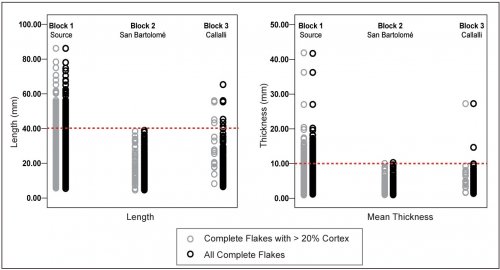7.7. Comparisons between Blocks with surface and excavated data.
7.7.1. Size of flaked stone artifacts
Given the proximity of an obsidian source of regional importance, there is a distinctive absence of large flakes in the immediate consumption zones of Survey Blocks 2 and 3. An examination of surface and excavated data, reveals an upper limit on artifact dimensions that suggests that local people were not consuming the larger nodules available at the Chivay quarry. The length and mean thickness of cortical and non-cortical complete flakes from surface and excavated contexts are shown inFigure 7-42. Early stage reduction flakes, taken here to be those with more than 20% cortex, made up 5% of all obsidian flakes in Blocks 2 and 3.
Figure 7-42. Flake metrics from Quarry area (Block 1) as compared with local consumption areas (Blocks 2 and 3). Red dashed line indicates upper size limits for B2 and majority of B3 evidence.
|
Survey Block |
||||||
|
Length (mm) |
1 |
2 |
3 |
4 |
5 |
Total |
|
< 10 |
57 |
16 |
1 |
10 |
84 |
|
|
10 - 20 |
288 |
36 |
7 |
2 |
36 |
369 |
|
20 - 30 |
264 |
19 |
7 |
14 |
31 |
335 |
|
30 - 40 |
128 |
8 |
5 |
15 |
9 |
165 |
|
40 - 50 |
73 |
2 |
3 |
2 |
80 |
|
|
50 - 60 |
21 |
2 |
1 |
24 |
||
|
60 - 70 |
12 |
12 |
||||
|
> 70 |
4 |
1 |
1 |
6 |
||
|
Total No. |
847 |
79 |
25 |
35 |
89 |
1075 |
Table 7-35. Counts by length for all complete obsidian flakes with ?20% dorsal cortex.
The presence alone of such flakes indicates that some obsidian cobbles were being transported from the source region and reduced in Blocks 2 and 3. There is a relatively clear distinction between the upper size limits of these early stage reduction flakes from Maymeja, and those appearing in Block 3, and, more strikingly, in Block 2 (Figure 7-42, dashed line). Cortical flakes over 40mm in length were common(9.7%)at the source workshop, but no cortical flakes at Block 2 were this length, and few cortical flakes in Block 3 exceeded 40mm in length(3.5%). Further, the large Block 3 early stage reduction flakes were predominantly Ob2 obsidian which is common in the Blocks 4 and 5 survey area. These data indicate that the reduction of large cobbles, such as those available in the Maymeja quarry, was notoccurring in the puna and upper valley blocks of the survey.
One may extend this analysis to all complete obsidian flakes, in case initial reduction (and decortication) of larger cobbles was occurring elsewhere with only later processing present in Blocks 2 and 3. With all complete flakes included these same limits on flake size are reinforced (seeFigure 7-42), again most markedly in Block 2. Thus, there are no flakes discarded in Blocks 2 or 3 that approach the flake size potential offered by the quarry source, even after initial decortication. This precludes distance decay as an explanation of this pattern for two reasons. The first is that the early stages of cobble reduction, as represented by cortical flakes, are present on site. Thus, complete or near-complete cobbles were being reduced locally, but the maximum size of flakes attainable from these cobbles had an upper limit (an absolute upper limit in the case of Block 2) of 40mm, substantially smaller than those produced in Block 1. The second is that in the reconnaissance of Blocks 4 and 5 there was a lack of significant intermediary consumption zones between the source and the puna and valley consumption zones.
